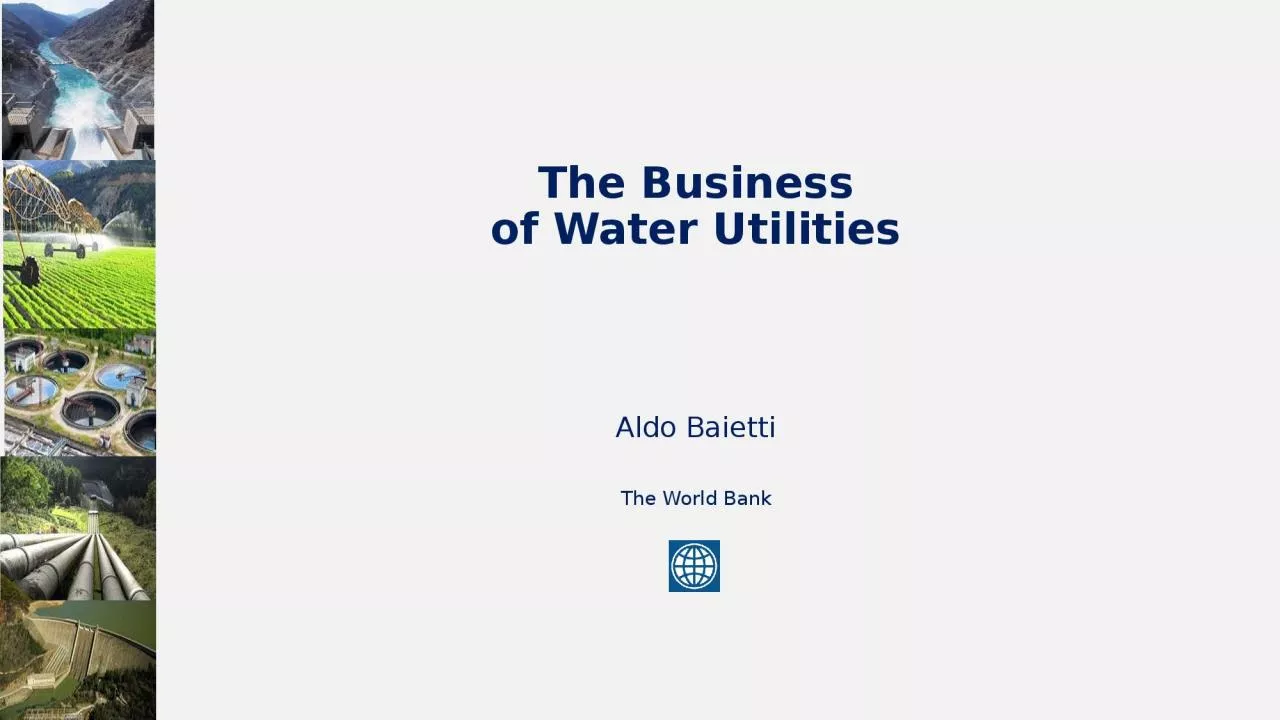

Aldo Baietti The World Bank June 2018 Source httpwwwfastcompanycomfilesimagecachemultimediaimagefilescsjpg Monopoly Water Utility Inc Someone called Customer is wanting ID: 935308
Download Presentation The PPT/PDF document "The Business of Water Utilities" is the property of its rightful owner. Permission is granted to download and print the materials on this web site for personal, non-commercial use only, and to display it on your personal computer provided you do not modify the materials and that you retain all copyright notices contained in the materials. By downloading content from our website, you accept the terms of this agreement.
Slide1
The Businessof Water Utilities
Aldo BaiettiThe World BankJune 2018
Slide2Source: http://www.fastcompany.com/files/imagecache/multimedia_image/files/cs.jpg
Monopoly Water Utility, Inc.
“Someone called
Customer
is wanting
something called
Service
!!”
Slide3What Does “Service” Mean
for a Water Utility?
Slide4Consumers only want piped service
Willingness to pay for piped service existsConsumers don’t have other choicesThe utility is a monopoly. Price and quality are non issues
Some False Assumptions
Slide5Consumers have options besides piped waterThey look at the cost of all their options
They consider all substitutes that best meet their interestsThe poor especially that have low monetary income prioritize alternatives that don’t require direct paymentUtilities often do compete for their piped service
Instead…
Slide6In most developing countries there are many substitutes for piped water
Groundwater/bore holes
Streams and Ponds
Rain Water Tanks
Vendors
Water Kiosks
Bottled Water
Slide7What is the Willingness to Pay?
Washing+
Bathing
+
Sanitation
+
Drinking
=
100% Daily
Need
30L/Day
15L/day
20L/Day
4.5 L/Day
69.5L/day
Streams
Ponds
Rainwater Tanks
Water Kiosks
Bottled Water
Private Vendors
If the consumer pays $10 m3 for drinking water from a vendor and opportunity cost only for the other sources, the daily monetary expense for drinking water is only 4.5 cents. To compete, the utility would need to charge less than 66 cents per m3.
Slide8But How Much Less?
Served by VendorM3 price = $10Price/liter = US 1 centLiters/person/day = 4.5Liters/month = 135Monthly Expense = $1.35/personServed by the Utility
M3 price = US 66 cents
Price/liter = US .066 cents
Liters/person/day = 66
Liters/month = 2045
Monthly Expense = $1.35/person
=
But…..Given that the substitutes are still available, will the consumer continue to use them at the expense of piped water. The consumer can substantially reduce its monetary expense by adding the piped-in alternative. But does this help the utility? Can it serve customers at such little revenue per household (e.g. Less than or equal to $6.75). OBA subsidies can pay for the connection but what about O&M?
Slide9The Utility will fail financially unless it knows its customers well
Understands their consumption behavior and
Aligns its services to meet their needs!
Slide10How Do We Find Out What Consumers
Want and Their Willingness to Pay?
Slide11Consumer Characteristics Vary
Slide12In Ghana, the WTP survey concluded:
Willingness to pay for improved sanitation services is high enough to cover the costs of ventilated pit latrines but not to cover the cost of sewer connectionsYour solution should reflect survey results!
What Service Do Consumers Want
and What They Are Willing to Pay For?
Slide13Evaluate survey data
Develop consumer classes
Differentiate services based on consumer class and coverage area
Understand user preferences
Address the needs of the poor
Use results in your planning and operations process
Design appropriate tariff structures
Aligning Services to Meet Your Customer Needs
Slide14Slide15Some Characteristics
Can’t pay up-front connection costsStruggle to pay monthly billsIncreasing block tariffs penalize sharing households
What about Un-Served Communities
So they tend to be overlooked by utilities
Slide16Targeted at the poor
LimitedTemporary
Ideal for investments and/or connections
Careful with O&M costs
Incorporate Subsidies that are:
Slide17Government to support capital costs
Donors and NGOs to provide technical and organizational assistance
Community to design, manage and pay for O&M
Link them to formal utilities
Provide small investment finance
Introduce regulation
Eliminate illegal activities
Empower Community Based Organizations
Slide18Give consumers a voice
Neutralize vested interestsEliminate administrative and legal barriers
Strengthen capacity, autonomy and accountability of providers
Adopt service
policies that best balance consumer interests with financial sustainability of the WSP
Overcome physical and technical barriers
Include un-served communities
In Summary